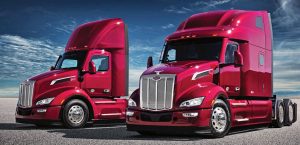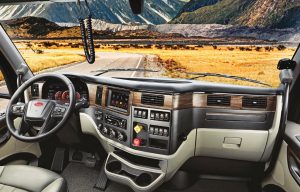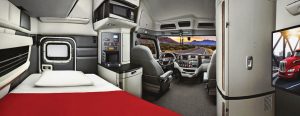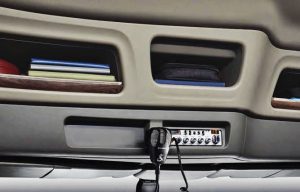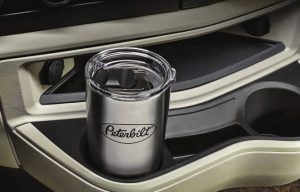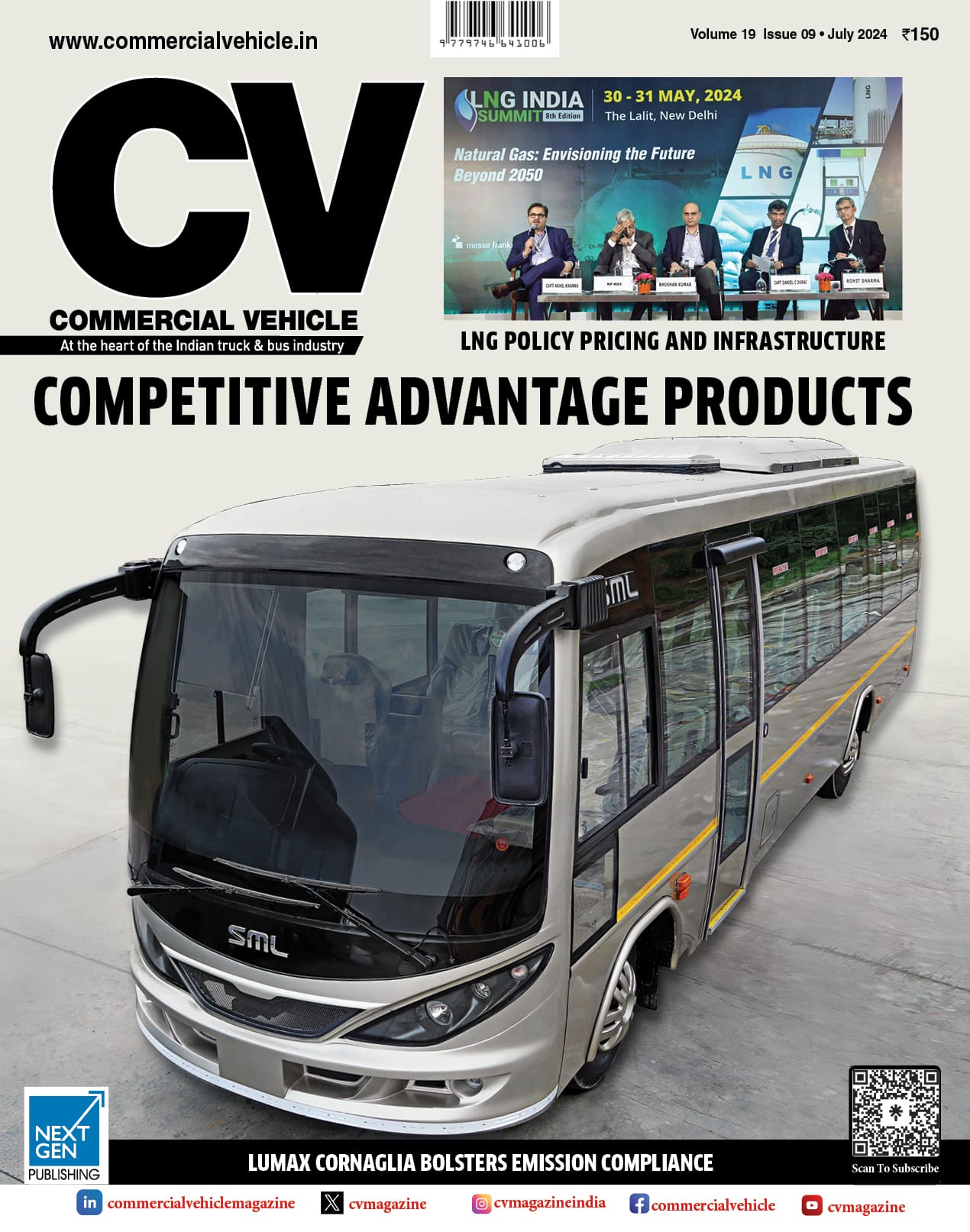
The Peterbilt Motors Company has launched the new 579 truck with aerodynamic changes to improve fuel efficiency.
Story by Team CV
Claiming to offer seven-per cent higher fuel efficiency, the new Peterbilt 579 marks a significant change in terms of market requirements. Made by the US-based Peterbilt Motors Company, the truck is said to offer among the most advanced aerodynamic features and packages ever. Compared to the earlier 579, the new model has a new hood and bumper. It also has, for maximum aerodynamic performance, a seemingly narrow front. The lower positioning of the hood apart, the Class-8 truck has aerodynamic mirrors that are a little shorter. Inspired by the look and shape of the Peterbilt bird that is positioned above the crown, according to Jason Skoog, General Manager, Peterbilt, and Vice President, Paccar, the new 579 does not sacrifice the red oval livery. It is considered as unique to every Class-8 Peterbilt truck. The livery is also claimed to pay homage to the tradition of the bird on this brand of trucks.
Describing the new 579 as a ‘New Era of Class’, Peterbilt, it is clear, is betting big. To begin production in April 2021, the new 579, according to Skoog, rub shoulders with the earlier generation ‘UltraLoft’ 579. Full fledged production of the new truck is expected to begin in the second half of 2021. Following in the footsteps of the successful ‘UltraLoft’ 579, which was first showcased in Mid-America Trucking Show in 2012, the new 579 does not simply present aerodynamic changes, but also significant technological changes that would enhance the performance, safety, reliability, efficiency and productivity overall. A good indicator of this is the Paccar MX engine that nicely blends efficiency and flexibility. It is an engine that boasts of one million miles in line-haul applications, which translates in the fact that 90 per cent of Paccar MX engines will present almost double the life of comparable engines. At the core is the B10 design life.
Paccar MX engine
Maximising kilometres on the road and the payload capacity, the Paccar MX 12.9-litre engine powering the new 579 produces 510 hp at the top. The stages below have the engine producing 485 hp, 455 hp, 430 hp, 405 hp and 380 hp. Also had with a Paccar MX-11 engine with a 10.8-litre displacement and power stages of 430 hp, 425 hp, 385 hp, 375 hp, 355 hp and 335 hp, the new 579 is about a combination of proven technologies and state-of-the-art innovations. Either engine, the MX-13 and the MX-11, employs a common rail system to maintain injection pressures of 2,500 bar. This helps in achieving the lowest possible fuel consumption, emission and noise levels. Mated to either engine is a Paccar 12-speed transmission as standard. The buyer has the choice of an Eaton manual or automated transmission, and also of an Allison automatic transmission.

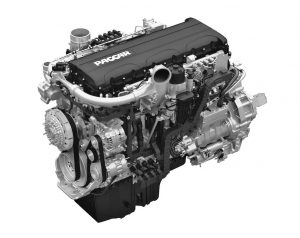
In the case of the axles, the new 579 offers a choice of a Dana, Hendrickson or Meritor front axle with a 12,000 – 14,600 lbs rating. The rear axle could be had by Paccar, Dana or Meritor. Producing a maximum torque of 1,850 lb. ft. in the case of the 510 hp Paccar MX13 powertrain variant, the new 579 is also supported by a choice of suspension, including Peterbilt Front Air Leaf, Hendrickson Softek and Taper Leaf at front. At the rear, the truck could be had with a Peterbilt Flex Air, Peterbilt Low Air Leaf, Peterbilt Low-Low Air Leaf, Peterbilt Air Leaf, Peterbilt Air Trac, Hendrickson HMX EX, Neway ADZ or Reyco suspension. Sporting a durable three-piece aerodynamic design made of metal with greater resistance to impact, the new 579 looks not just at the best in class aggregates and an ability to meet the finest customer requirements, but also at lowering the TCO. The hood, designed to improve the airflow over the top and around the sides of the vehicle, is part of an effort that includes a bumper with lights in it.
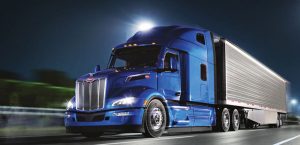
The lights comprise three functions: fog lamp, driving lamp and cornering lamp. Turning on automatically with the turn signal in low light conditions, the lights provide excellent illumination at both corners of the truck. They improve safety and minimise the chance of an accident. Fitted with LED headlamps that include InfraRed heater elements for lens defrost to ensure no ice and snow collects, the 579 is easy to recognise because of its signature style daytime running lamps. If the LED headlamps consume less energy than the halogen bulbs on the earlier model, the new truck with an aerodynamic hood and three-piece bumper has got new aerodynamically designed rear view mirrors. While the new A-pillar fairing directs air across the side of the cab to improve aerodynamics and reduce noise, new wheel-well close outs provide added aerodynamics and accommodate more tyre options than ever before.
Tandem fairings and wheel covers along with the new chassis fairings reduce drag. The new redesigned and re-imagined chassis fairings enhance serviceability whereas the newly designed front chassis and powertrain helps to reduce noise in the cab by 10 per cent. Providing the driver with additional control and comfort, the new 579 could be had with Aero, Advanced Aero and Advanced Aero with Digital Vision System options. The Aero packages help deliver up to seven per cent improvement in fuel economy, validated through computational fluid dynamics and thousands of miles of on-road validation. The Advanced Aero and Digital Vision System is claimed to provide expanded field of view, improved visibility in inclement weather, night vision and selectable views like discrete, merged and look down. Available with full-height aerodynamic cab mirrors as optional; with optional rear fairings to further enhance aerodynamic efficiency; with chassis fairings redesigned for fuel efficiency without sacrificing great entry and exit out of the cab, and tip out features that make it easy to access batteries as well as fuel tanks, the new 579 seeks technological edge through digital display and ADAS.
A bold design with class-leading functionality, the digital display includes a configurable interface with all critical truck systems information and integrated Advanced Driver Assistance Systems (ADAS) technology and features, including adaptive cruise control, lane-keeping assist and signs recognition. Drivers and fleets can personalise their default view, placing the most relevant information at their preferred location on the screen. Lowering the driver’s workload and enhancing overall safety and uptime, the truck integrates high-definition camera and radar technology to enable features like overspeed alerts, collision mitigation, Lane Departure Warning (LDW) and Lane-Keeping Assist (LKA). LKA utilises an electric motor mounted on the steering column to assist the driver in staying between the travel lanes. Collision mitigation is triggered by a slower moving vehicle or stationary object ahead, and automatically engages the brake system, reducing vehicle speed by up to 80 kph, minimising the likelihood of loss of control situations or collisions.
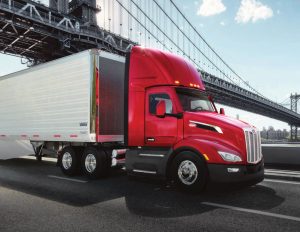
Capable of detecting when the truck is unintentionally drifting out of the travel lane and alerting the driver to take action, the new 579 sounds an audible alert for the driver and applies foundation brakes to reduce vehicle speed. Side object detection provides visual and audible warnings when vehicles are travelling in the truck’s passenger-side blind spot. A part of the driver’s cockpit or cabin, which has been updated with richer colours and luxurious optional wood trim, the strong arm of technology is felt time and again. Incorporating a 15-inch digital display, which is claimed to be the largest in its class, the truck has its cabins designed to minimise driver distractions while driving. Offering eight feet of headroom, 70 cubic feet of storage and the large mattresses, the new 579 accommodates a television as big as 32-inch; a 1.1-cubic foot microwave, and a clever foldaway ladder that disappears when not in use. The truck could be had with a sound abatement technology, independent heating, ventilation, and air conditioning (HVAC) with separate controls, an optional fuel-fired heater and multiple no-idle hoteling options. LED lighting throughout provides optimal illumination with energy-saving.



